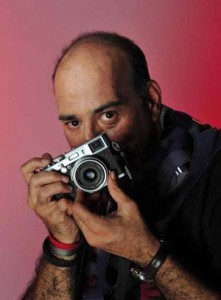Double Trouble: Photography by Arif Mahmood and Tapu Javeri
By Maheen Irfan Ghani | Arts & Culture | Published 14 years ago

The ‘project’ Arif Mahmood refers to is the book Dou Rukh, published by Markings and launched with an accompanying exhibition of photographs on September 30 at the Indus Valley School of Art and Architecture (IVS) gallery, in Karachi. Veteran photographer Arif Mahmood teamed up with his friend and photographer from the jewellers’ fraternity, Tapu Javeri, to show 18 portraits each. Dou Rukh draws upon its literal meaning of two sides and illustrates one subject from both Arif and Tapu’s perspective. Both perspectives, displayed side-by-side, are meant to spark a discussion on the marked difference not only in their individual outlook, but light, composition, technique and vision when dealing with the same subject. Tapu succinctly describes the endeavour as “an opportunity for Arif and I to show how differently we envision the different subjects and hence the world.”
The book has two covers; Arif’s photographs begin on one side, and mid-way Tapu’s photographs are published in vertical form, the other way round — thus Tapu’s cover at the back, is also a front cover. The portraits feature several celebrities such as film actress Reema Khan, musician-turned-actor Ali Zafar, TV host Mathira, fashion model Ayyan and notable figures like humanitarian Abdul Sattar Edhi, artist Durriya Kazi, qawwals Farid Ayaz and Abu Mohammad, architect Habib Fida Ali, ex-cabaret dancer and socialite Marzi, restaurateur Mahmood Bundo Khan, comedian Durdana Butt, media personality Imran Aslam and poet Zehra Nigah. The basis for this selection, according to Arif Mahmood, was the photographers’ moods and the subject’s availability.
Tapu and Arif’s styles are, indeed, poles apart. Arif has his subjects look away from the lens in most photographs, perhaps in an attempt to make them appear ponderous, while Tapu constantly pushes the boundary with his more than lenient use of Photoshop, capturing more candid shots. Arif’s portraits focus more on the lighting and surroundings, whereas Tapu concentrates more on the subject.
Looking at Tapu’s portrait of the ex-cabaret dancer and socialite, Marzi, one feels as though one has stumbled upon a very private moment in her boudoir, as she sits down to apply lipstick in front of a mirror, which has old black-and-white pictures from Marzi’s younger days taped onto it. Fashion designer Rizwan Beyg’s portrait by Tapu is equally bold, flaunting his flamboyant side in a bid to rule the fashion world. Tapu explains: “In order to take a great picture I have to get to know my subjects intimately and relate to them. So this is how each portrait becomes a conversation between photographer and subject. Like people, some pictures only talk about the weather, while others delve deeper.” Well, in this case, Tapu has definitely dug deep.
The self-portraits are particularly intriguing; Tapu’s comical image of himself playing around in a pile of money offers a stark contrast to Arif’s self-portrait holding a camera in the early morning light, trying to cleverly play off light against shadow.
“A portrait says many things about the subject, but also has the photographer’s mind frame in it. I see things very compositionally, so I am constantly struggling with where to place the individual in the frame,” says Arif. His shots of Abdul Sattar Edhi and Durriya Kazi are both unique in their composition. “A shadow, soft light, a shift in the expression and the shutter clicks. One struggles with past images, but a different perspective is needed to excite me, otherwise it’s an exercise in documentation only. The power of the subject should never be underestimated,” says Arif.
Tapu Javeri’s Tapulicious and Shades of Green and Arif Mahmood’s To Live in Freedom and Invisible Boundaries — some of their previous publications — have all been very well received. Dou Rukh features the artists’ latest work and makes for an interesting coffee table read.


